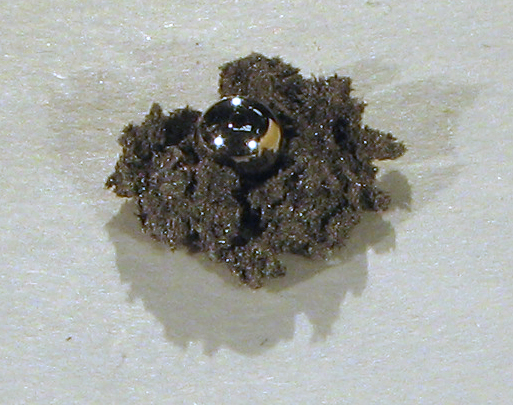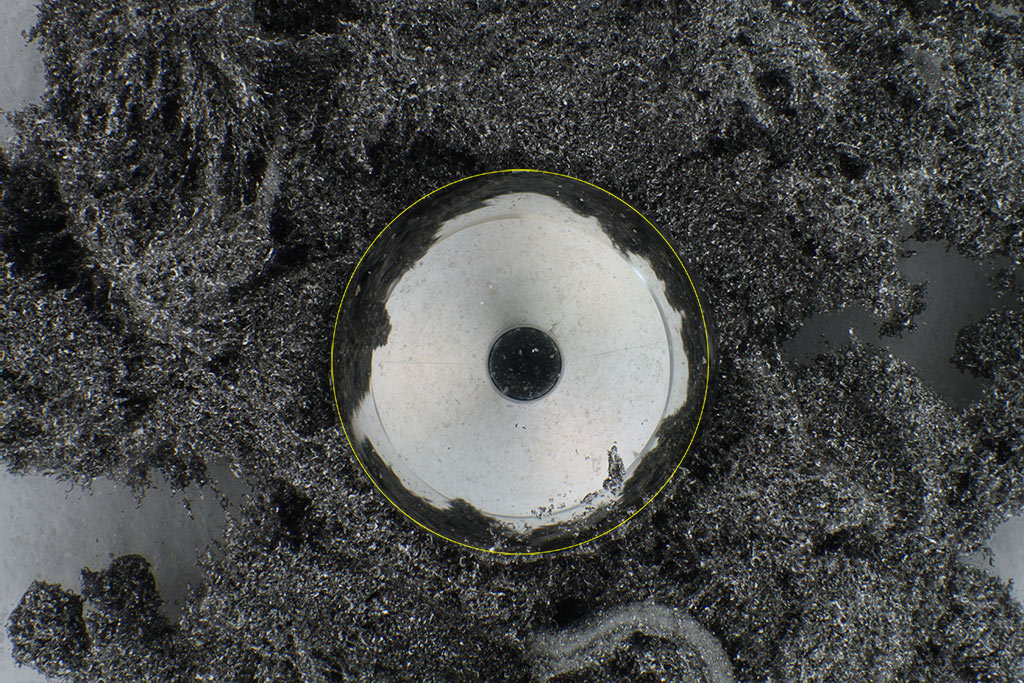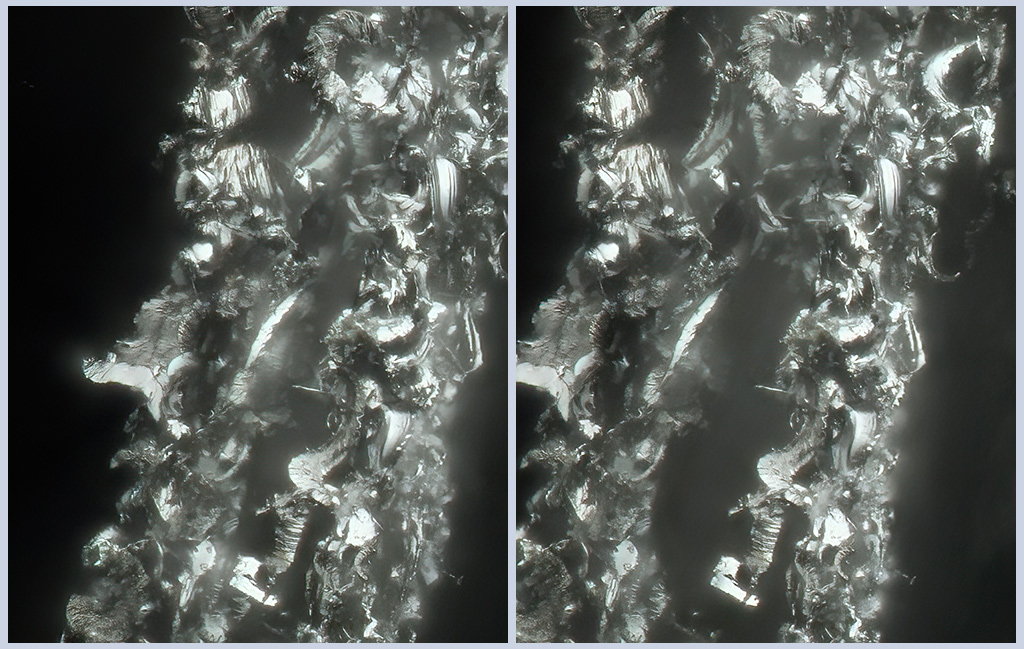Periodically the magnet is supposed to be removed and cleaned. Every time I remove it, I have been intrigued by the large-scale patterns that have formed around the magnet. This time I decided to spend some time photographing them.
Starting with wide angle and working closer, all images are crossed-eye stereo pairs.
First we have the whole magnet. You can immediately see how the debris organizes itself into strings of particles that follow the field lines of the magnet. The pattern of those lines may seem odd, until you realize that the debris catcher is just an oddly proportioned bar magnet. The "ends" of the bar magnet, its north and south poles, are very close together, on the top and bottom surfaces in this photo. The long dimension of this magnet would be the width of a conventional bar magnet. So, the lines of force have the pattern shown at http://hyperphysics.phy-astr.gsu.edu/hbase/magnetic/elemag.html , forming a sort of cylindrical shield around the front of this magnet, and diving almost vertically into the top and bottom.
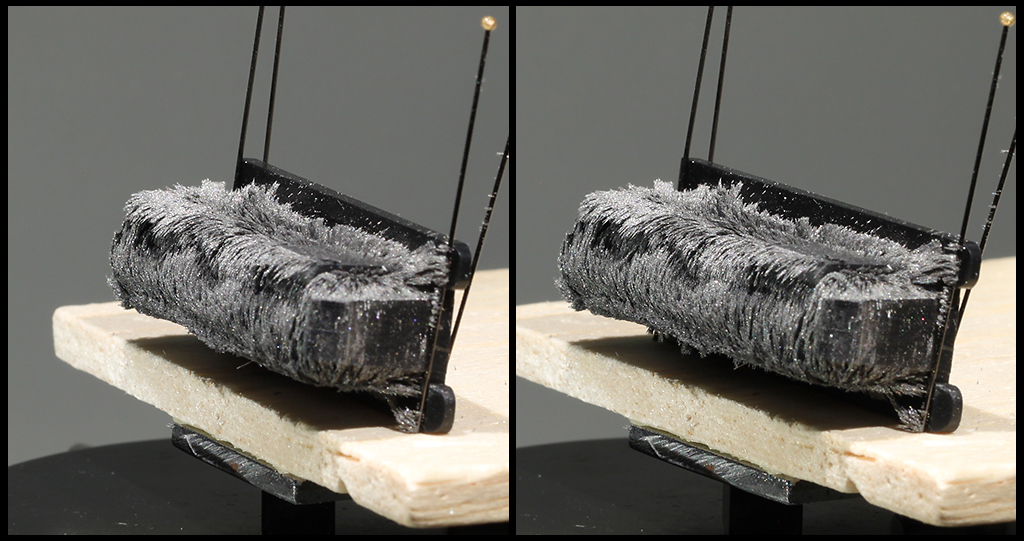
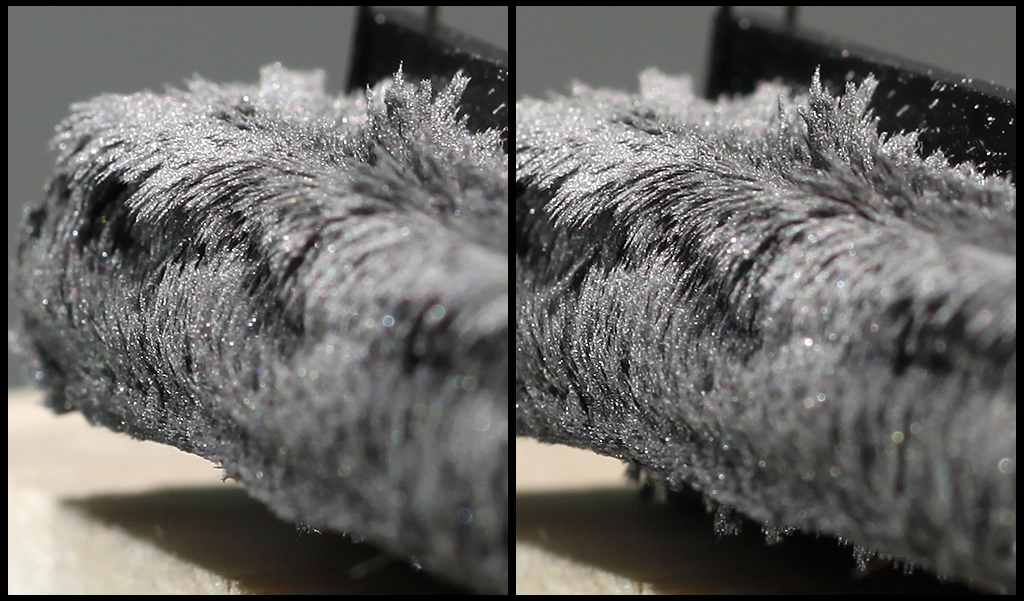
This is a view straight into the long face of the magnet. I've marked the small area where we'll look much closer.
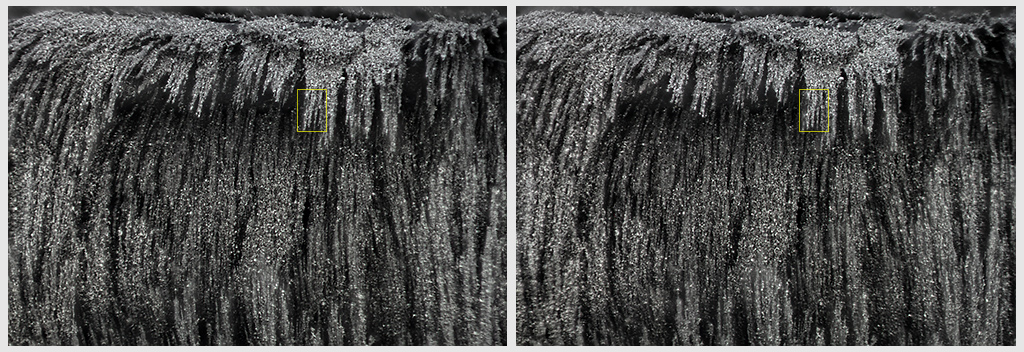
Here we can start to see details of the debris. Stereo helps a lot, if you can see that.
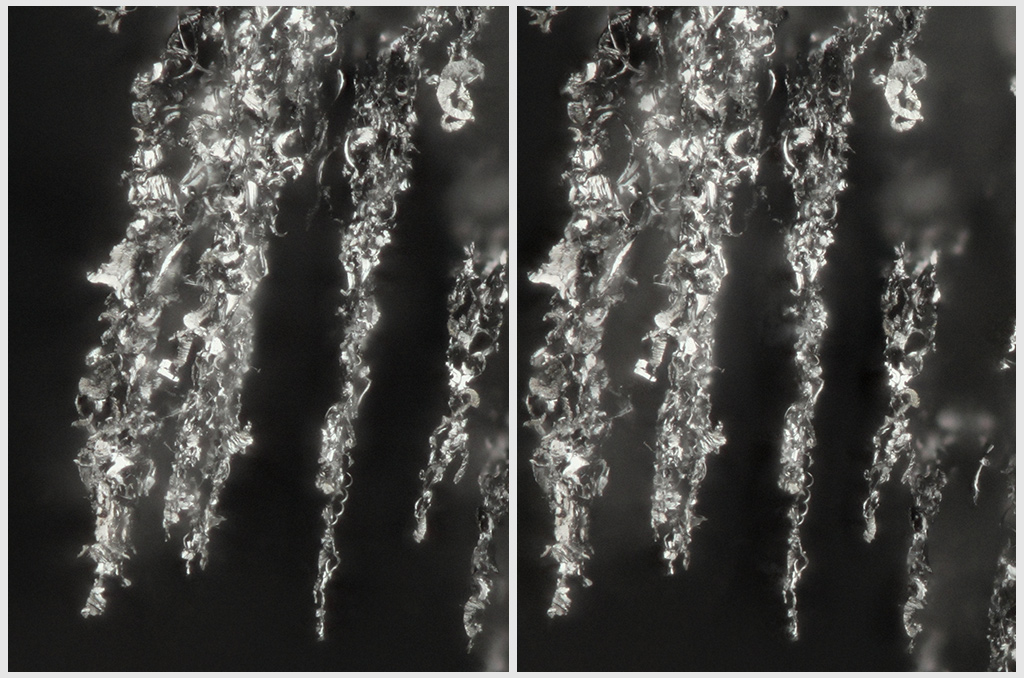
Cropping in even closer, we can see that the debris takes the form of flat shavings and even some long thin curls.
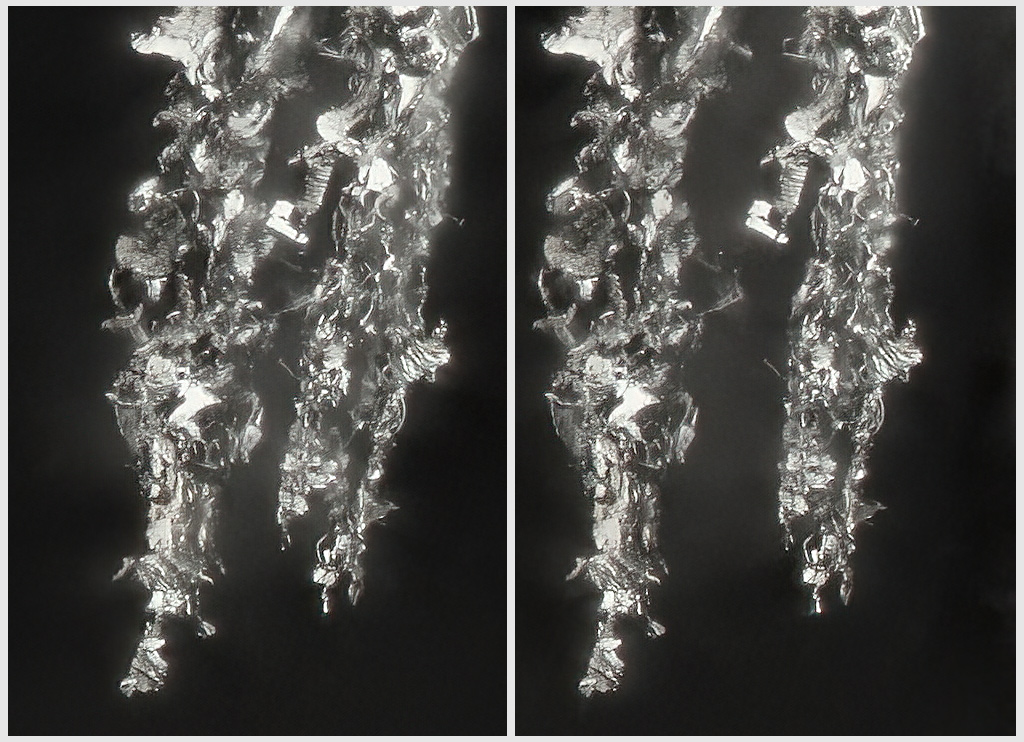
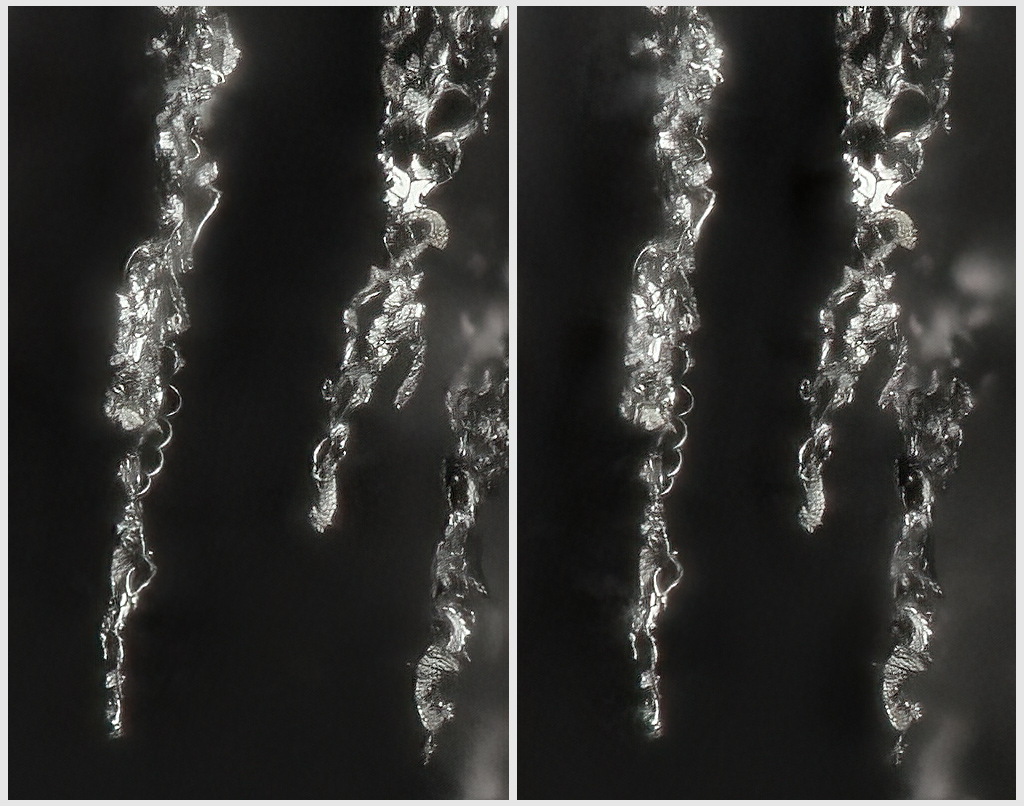
These particle shapes are not even close to the compact sand-like grains that I was implicitly expecting to see. I say "implicitly expecting" because I do not recall any explicit expectations, but I definitely recall being surprised by what I saw. In retrospect, these shavings and curls are "exactly what you'd expect" from very hard sharp edges being scraped across fairly ductile stainless steel, assuming of course that you've had the appropriate experience and made the connection properly. I've worked a fair bit with metal and know how it behaves at larger scales, but somehow I missed the now obvious connection to smaller scales.
That said, it turns out that the connection to smaller scales is in fact not so obvious, or at least not so consistent, even though sharpening processes have been studied intensively for many years. For those interested in such things, I will only point to the discussion at https://scienceofsharp.com/2015/03/01/the-diamond-plate-progression/ . Copying relevant snippets from near its beginning...
Studying the sharpening process would be a fun rabbit hole to dive down, but this exercise has already taken far too much time, most of it struggling to get decent illumination for this stuff that looks dark gray at low mag but at high mag resolves to be a bunch of mirror surfaces at extreme angles and small scales. The results shown here took more diffusion and more fiddling than I have ever had to use with even the shiniest insect. In the end I simply gave up on the three 20X stacks that I shot, and backed off to the 10X which provides a little wider range of available angles for illumination.In The Honing Progression entry, an example of apex geometry refinement during honing with Shapton glass stones was presented. A slow, but linear improvement in sharpness and keenness was observed, consistent with the intuitive view that reducing abrasive size (increasing grit) leads to a sharper, keener and more linear edge, along with a more polished bevel. In the current discussion, examples taken from honing on diamond plates will show that the reality can be more complex.
...
A set of 4 diamond plates were used for this experiment; DMT coarse (325), fine (600), extra-fine (1200) and extra-extra-fine (8000).
...
Comparing side view images, all at 5000x magnification, shows that the roughness of the bevel actually increases with grit, rather than decreases as was observed with the Shapton water stones. The scratches are wider and shallower on the lowest grit hones, becoming progressively deeper with increasing grit.
Images #1 and #2 with Canon EF 100mm f/2.8L Macro IS USM at f/16 and f/5.6, single focus point using cha-cha stereo, 3 undiffused Jansjo lamps. Image #3 with SK Componon-S 50/2.8 at 12.3 mm field width, wide open, focus step 0.04 mm, hemispherical diffuser plus Kleenex over the back, 4 Jansjo lights evenly distributed, ISO 100 at 1/15 second. Images #4 through #6 with Mitutoyo M Plan Apo 10X on Raynox 150 at infinity focus, 0.007 mm focus step; diffuser from LED tube light, plus Kleenex tissue over top for more diffusion and reduced brightness. Three flashes positioned at roughly 11, 1, and 7 o’clock, flag added to eliminate one nasty streak where the subject saw a bit of flash directly. ISO 100 at 0.5 seconds with 2nd curtain flash, 1/32 power on the flashes. Canon 580 EX II and Yongnuo YN 460-II.
All of the synthetic stereo pairs are +-3 degrees, using larger than normal focus step to avoid horizontal streaking. The 1.8X series was particularly extreme; it was shot at 0.04 mm focus step based on calculated DOF of 0.045 mm, but then stacked every 5th frame so effectively 0.2 mm focus step. I suspect that the mirror-like quality of these particles produces larger than normal DOF, due to utilized-aperture effects, despite the very diffuse illumination. At any rate the stereos looked better with large focus steps than small.
--Rik
Edit: add details regarding stacking the 1.8X series.

